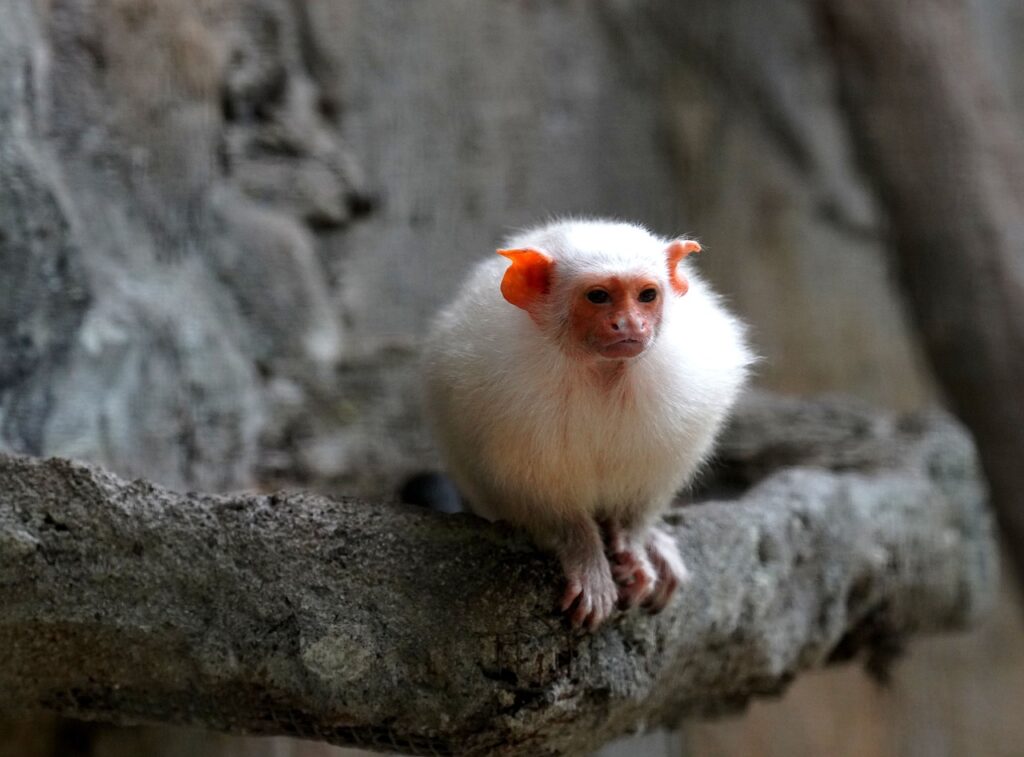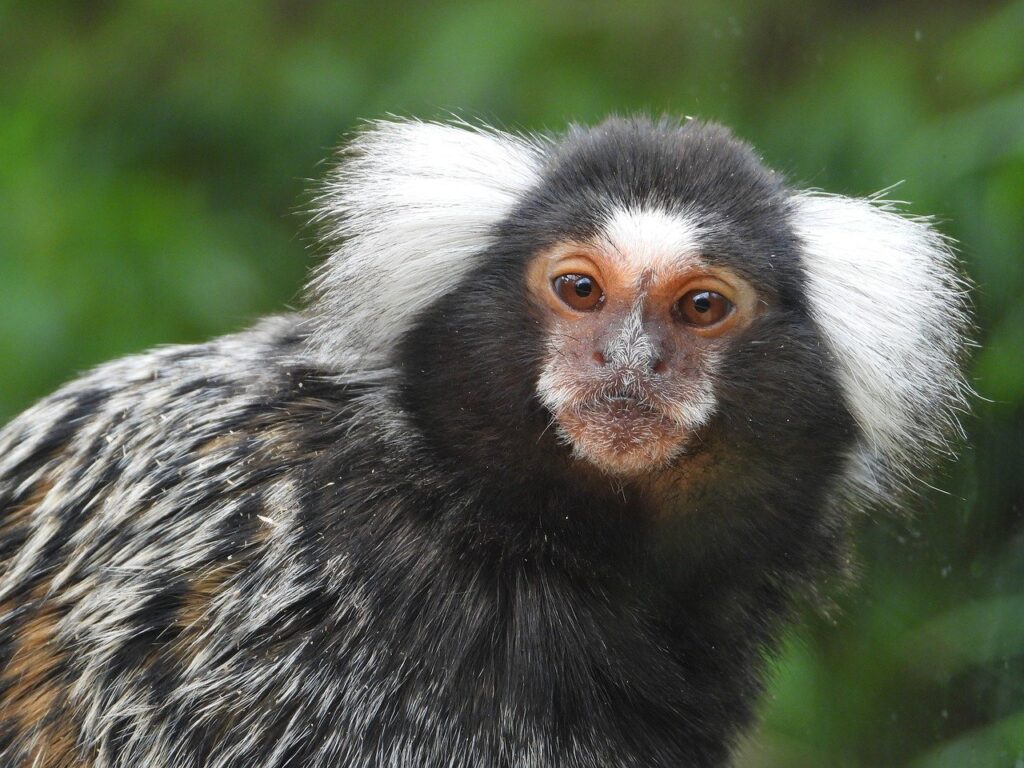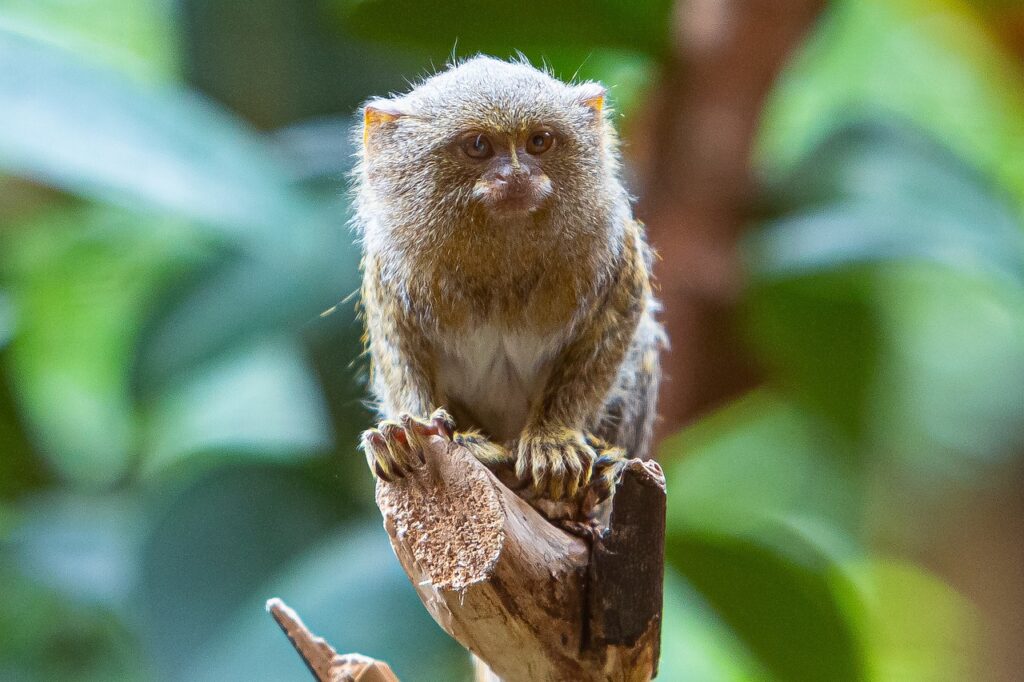Are you ready to explore the captivating world of the smallest monkeys?
Get ready to be amazed by these tiny creatures that inhabit different parts of the globe. From the adorable Pygmy Marmoset to the elusive Talapoin Monkey, each of these miniature primates has its own unique characteristics and fascinating behaviors.
In this article, we’ll delve into their habitats, physical features, and the important roles they play in their ecosystems.
So, join us on this journey and uncover the secrets of the world’s smallest monkeys.
Key Takeaways
- The smallest monkeys in the world include the Pygmy Marmoset, Roosmalens Dwarf Marmoset, Silvery Marmoset, and Common Marmoset.
- These monkeys can be found in South America, specifically in the Amazon Rainforest and Brazil.
- The smallest monkey on the list is the Pygmy Marmoset, measuring only 4.6 to 6.0 inches in length.
- While these monkeys are not suitable as pets, observing them in their natural habitat can be a fascinating experience.
create a size comparison table of pigmy marmoset, roosmalens dwarf marmoset, silvery marmoset, common marmoset, dusky titi marmoset ana talapoin monkey
| Species | Weight (kg) | Body Length (cm) | Tail Length (cm) | Height (cm) |
|---|---|---|---|---|
| Pygmy Marmoset (Callithrix pygmaea) | 0.14-0.22 | 13-15 | 18-22 | 10-12 |
| Roosmalens’ Dwarf Marmoset (Callibella humilis) | 0.13-0.19 | 12-14 | 17-20 | 9-11 |
| Silvery Marmoset (Callithrix argentata) | 0.23-0.33 | 18-22 | 25-30 | 12-15 |
| Common Marmoset (Callithrix jacchus) | 0.25-0.35 | 18-22 | 25-30 | 12-15 |
Pygmy Marmoset
If you’re fascinated by the world’s smallest monkeys, you’ll want to learn about the Pygmy Marmoset (one on the featured photo), a tiny primate found in South America. The Pygmy Marmoset, scientifically known as Cebuella, is a remarkable creature with distinct identification features. It measures between 4.6 to 6.0 inches in length and weighs about 3.5 ounces. Its fur comes in various shades of brownish gold, grey, and black, blending perfectly with its surrounding environment. One of its most notable features is its long tail, which aids in balance and mobility.
The natural habitat of the Pygmy Marmoset is the South American rainforests, including the countries of Peru, Brazil, Ecuador, and Colombia. These agile primates are highly adapted to the dense vegetation, where they spend their lives in the upper canopy. Their nimble bodies and sharp claws allow them to navigate the intricate branches with ease. They’re predominantly arboreal, rarely descending to the forest floor.
In terms of behavior, Pygmy Marmosets are highly social creatures. They live in family groups consisting of a breeding pair and their offspring. These groups communicate through various vocalizations, including trills, clicks, and whistles. Additionally, they mark their territories with scent glands located on their chest and genital area.
The Pygmy Marmoset’s diet primarily consists of tree sap, gum, and resin, which they obtain by gouging holes in the bark with their sharp teeth. They also consume fruits, insects, and small vertebrates when available. They’ve a unique ability to metabolize the toxins found in certain plants, allowing them to feed on a wide variety of food sources.
Roosmalens Dwarf Marmoset
The Roosmalens Dwarf Marmoset, also known as Mico Humilis, is another fascinating species of small monkey found in the Amazon Rainforest. This tiny primate measures around 15 to 15.5 inches in length and weighs between 5.5 to 6 ounces. One of the key identification features of the Roosmalens Dwarf Marmoset is its dark olive-brown upper parts, which contrast with its pale pinkish face. Another interesting aspect of this monkey is its red belly, which sets it apart from other marmoset species.
The natural habitat of the Roosmalens Dwarf Marmoset is the Amazon Rainforest, where it resides primarily in the tree canopies. This species is highly arboreal, spending most of its time climbing and leaping between branches. Its small size enables it to navigate through the dense vegetation with ease. The Roosmalens Dwarf Marmoset is also known for its social behavior, living in family groups of around 6 to 10 individuals. These groups consist of a dominant breeding pair and their offspring.
Silvery Marmoset
Continuing our exploration of the smallest monkeys in the world, let’s turn our attention to the Silvery Marmoset, a fascinating species found in the Amazon Rainforest.
The Silvery Marmoset, scientifically known as Mico argentatus, is a small primate with a length ranging from 7.1 to 11 inches and a weight between 11 to 14 ounces. Its identifying features include silver fur and a dark tail.
The natural habitat of the Silvery Marmoset is the dense forests of the Amazon Rainforest. This species thrives in the trees, where it spends the majority of its time. It’s highly adapted to an arboreal lifestyle, with its long tail providing balance and agility as it leaps from branch to branch. The Silvery Marmoset is known to be highly social, living in groups of up to 15 individuals, comprising of a dominant breeding pair and their offspring.
In terms of behavior, the Silvery Marmoset is diurnal, meaning it’s most active during the day. It primarily feeds on fruits, nectar, and small insects. Its small size allows it to exploit food sources that larger primates may not be able to reach. Additionally, the Silvery Marmoset has a unique vocal repertoire, using different calls and vocalizations to communicate with its group members and defend its territory.
The Silvery Marmoset’s natural habitat and behavior are intricately interconnected. Its ability to navigate through the dense rainforest, forage for food, and communicate effectively with its group members are all essential for its survival in the challenging Amazonian environment. Understanding the natural habitat and behavior of the Silvery Marmoset provides valuable insights into the life and ecology of this remarkable species.

Common Marmoset
Now let’s take a closer look at the Common Marmoset, a small primate found in Brazil. The natural habitat of the Common Marmoset includes the Atlantic coastal forests and the eastern Amazon rainforest. These monkeys are highly adaptable and can be found in various types of forests, including disturbed and secondary forests. They’re known for their social behavior, living in family groups of up to 15 individuals. These groups consist of a dominant breeding pair and their offspring.
The Common Marmoset is an omnivorous species, feeding on a variety of foods such as fruit, nectar, insects, and even small vertebrates. They’ve specialized teeth for gouging tree bark to access gum, a vital part of their diet.
In terms of conservation status, the Common Marmoset is listed as Least Concern by the International Union for Conservation of Nature (IUCN). However, they face certain threats in their native habitat. Deforestation, primarily due to agriculture and urbanization, is a significant threat to their survival. Additionally, the illegal pet trade poses a threat to their population, as they’re often captured and sold as pets.
Conservation efforts are focused on protecting their natural habitat and raising awareness about the importance of preserving these unique primates.

Importance of Small Primates
Small primates play a crucial role in their ecosystems, frequently contributing to the balance and diversity of their habitats. These tiny creatures have a significant impact on the environment due to their unique behaviors and ecological interactions. Understanding the importance of these small primates is essential for effective conservation efforts and the preservation of their natural habitats.
| Importance of Small Primates |
|---|
| 1. Seed Dispersal |
| 2. Pollination |
| 3. Pest Control |
| 4. Nutrient Cycling |
One of the key roles that small primates play is seed dispersal. They consume fruits and then disperse the seeds through their feces, allowing for the establishment of new plant populations. This process is vital for maintaining forest regeneration and the overall health of the ecosystem.
Additionally, small primates contribute to pollination by transferring pollen from one flower to another as they feed on nectar. This interaction between the primates and flowering plants is crucial for plant reproduction and the production of fruits and seeds.
These primates also provide pest control services by feeding on insects and other small invertebrates. By reducing the population of these pests, they help maintain the health of plants and prevent the spread of diseases.
Furthermore, small primates contribute to nutrient cycling within their habitat. Through their feeding and defecation behaviors, they redistribute nutrients in the environment, enhancing soil fertility and supporting the growth of vegetation.
Understanding the importance of small primates in their ecosystems is essential for conservation efforts. By recognizing their ecological roles and protecting their natural habitats, we can ensure the survival of these unique creatures and the preservation of the delicate balance of their ecosystems.
In captivity, small primates display a range of behaviors that are important to study and understand. Observing their behavior in controlled environments can provide valuable insights into their social interactions, reproductive strategies, and overall well-being. This knowledge can then be applied to improve the welfare of captive individuals and inform conservation efforts in the wild.
Size comparison table of smallest monkeys in the world
| Monkey Species | Average Weight (kg) | Average Length (cm) | Comparison to Common Objects |
|---|---|---|---|
| Pygmy Marmoset | 140-150g | 13-15cm | Slightly larger than a human hand |
| Pygmy Titi | 150-200g | 15-18cm | Similar to a large apple |
| Mouse Lemur | 200-300g | 15-20cm | About the size of a small banana |
| Dwarf Lemur | 250-300g | 18-22cm | Similar to a large pear |
| Slow Loris | 300-400g | 20-25cm | About the size of a small melon |
| Capuchin Monkey (infant) | 300-400g | 20-25cm | Similar to a large orange |
| Titi Monkey | 400-500g | 25-30cm | About the size of a large grapefruit |
| Owl Monkey | 500-600g | 25-30cm | Similar to a small pineapple |
Note: The weights and lengths listed are averages and can vary depending on the subspecies and sex of the monkey.
Here’s a rough estimate of how these smallest monkeys compare in size to common objects:
- Pygmy Marmoset: fits in the palm of your hand
- Pygmy Titi: similar to a large apple or a small pear
- Mouse Lemur: about the size of a small banana or a large kiwi
- Dwarf Lemur: similar to a large pear or a small melon
- Slow Loris: about the size of a small melon or a large grapefruit
- Capuchin Monkey (infant): similar to a large orange or a small pineapple
- Titi Monkey: about the size of a large grapefruit or a small pineapple
- Owl Monkey: similar to a small pineapple or a large papaya
Keep in mind that these comparisons are rough estimates and are meant to provide a general idea of the size of these small monkeys.

Erzsebet Frey (Eli Frey) is an ecologist and online entrepreneur with a Master of Science in Ecology from the University of Belgrade. Originally from Serbia, she has lived in Sri Lanka since 2017. Eli has worked internationally in countries like Oman, Brazil, Germany, and Sri Lanka. In 2018, she expanded into SEO and blogging, completing courses from UC Davis and Edinburgh. Eli has founded multiple websites focused on biology, ecology, environmental science, sustainable and simple living, and outdoor activities. She enjoys creating nature and simple living videos on YouTube and participates in speleology, diving, and hiking.
🌿 Explore the Wild Side!
Discover eBooks, guides, templates and stylish wildlife-themed T-shirts, notebooks, scrunchies, bandanas, and tote bags. Perfect for nature lovers and wildlife enthusiasts!
Visit My Shop →
